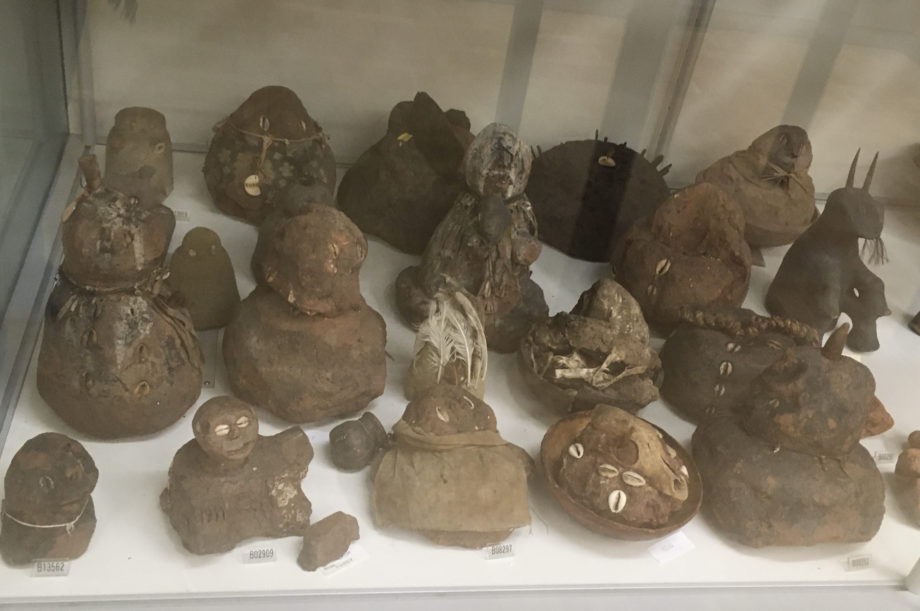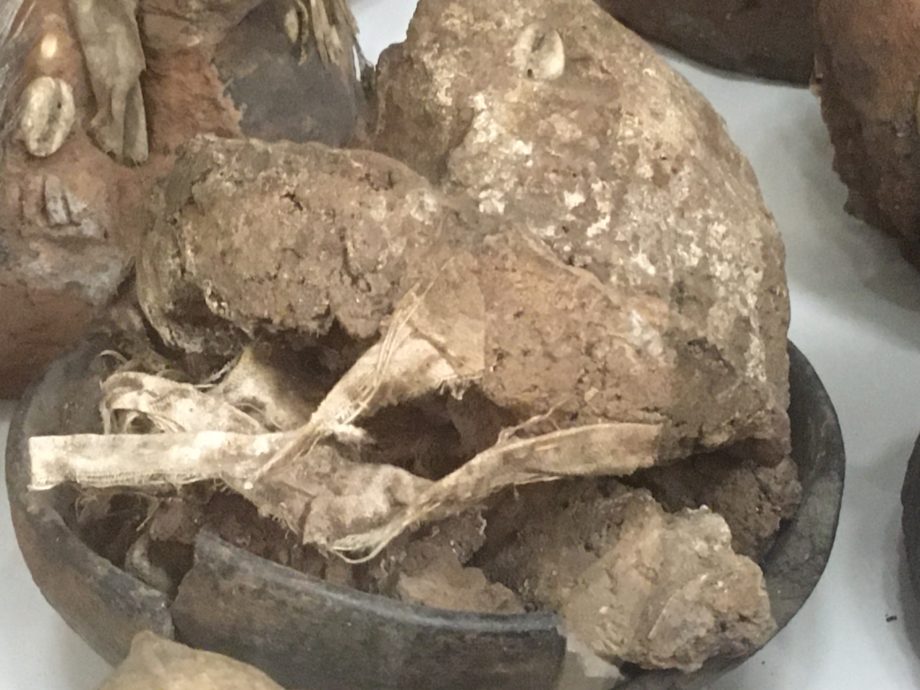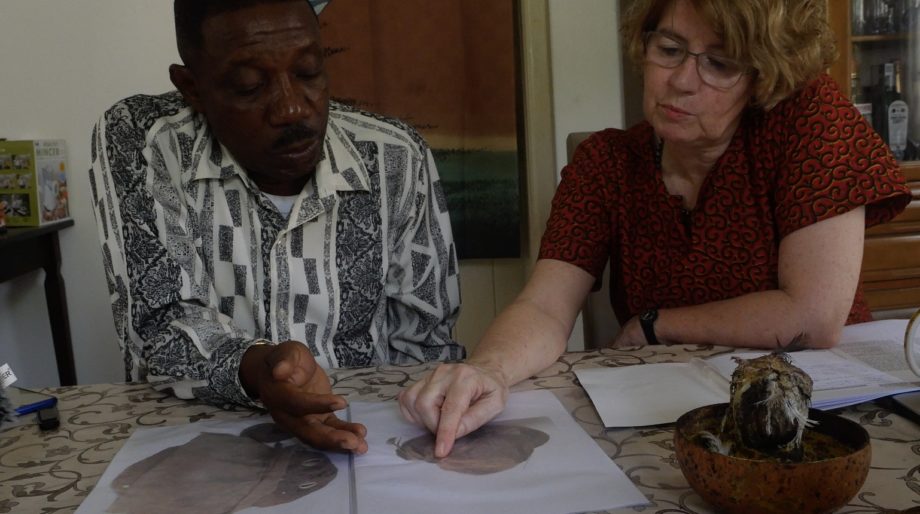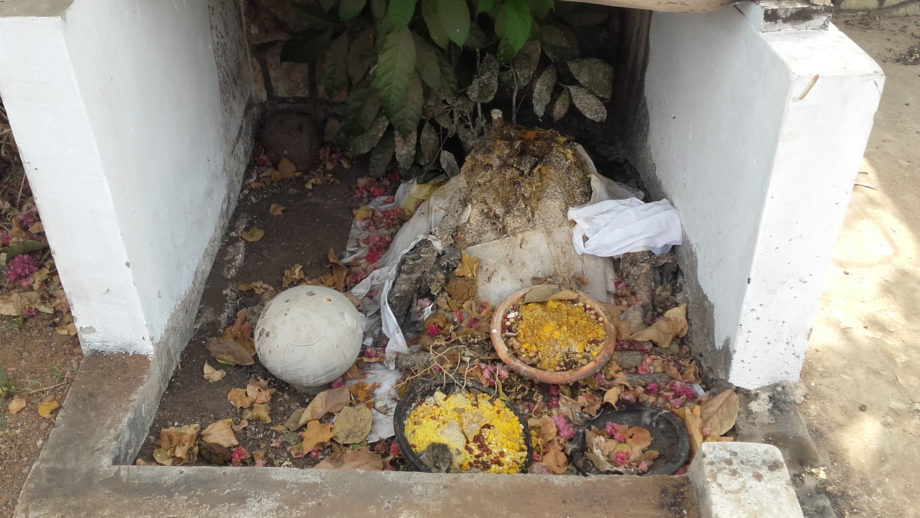Legba-figures and dzokawo
Unpacking a missionary collection from the Übersee-Museum Bremen
In the debate about colonial collections in ethnological and other museums, little attention has been paid to things[1] acquired in the context of evangelization in the “frontier zones” (Chidester 1996) of European imperial outreach. Conversion to Christianity in colonial contexts, as a rule, implied that converts were required to give up the material related to their previous worship. While the iconoclasm ensued by the (Calvinist) Reformation has gained some public and scholarly attention, especially in the aftermath of the 450th anniversary of the beeldenstorm (Bildersturm) in the Low Countries in 1566, it is less known that Protestant and Catholic missions instigated iconoclasm in their mission areas in the colonial period, and beyond (Memel-Kassi 2020; Thomas 1991: 151-162). Disqualified as “idols” and “fetishes,” these things were to be handed in and destroyed. But not all. Some things were assembled and taken to Europe: as trophies testifying to the mission’s success, as objects for further research on presumably “low” stages of religion such as “animism” or “fetishism,” and as exotic items for display in the museum.
Not fitting into the currently much discussed category of looted art and, to my knowledge, so far barely subject to demands for repatriation, such things are particularly important to attend to. I propose to approach them as “religious matters”[2] that enshrine colonial and post-colonial entanglements of people, objects and ideas in Africa and Europe. As part of collections assembled in colonial times and now kept in the museum, they are also “pressing matter” (Modest 2017) in need of scrutiny. Research on such collections that still linger in museum depots unstudied is now slowly taking off (Corbey 2019; Jacobs, Knowles, Wingfield 2015; Weener 2020). They contain complex colonial entanglements that are to be unpacked through collective and collaborative research involving curators, anthropologists, religious studies scholars, art historians and archaeologists from Europe and the Global South, as well as stakeholders from the communities of origin.
Currently, I am involved in two projects that focus on objects assembled in the context of missionary Christianity in colonial settings. One is the “Pressing Matter: Ownership, Value and the Question of Colonial Heritage in Museums” research program co-directed by Wayne Modest and Susan Legêne, in the context of which my colleague Peter Pels and I work on a research project titled “Heritage and the Question of Conversion” that focuses on missionary collections from former Dutch-Papua (now West Papua, Indonesia) and West and Central Africa in the National Museum of World Cultures; this project is in its preparatory stage. The other project, on which I will concentrate in this blog entry, focuses on the legba figures (so-called “idols” and “fetishes”) and dzokawo (so-called “charms”) collected among the Ewe by the missionary Carl Spiess (1867-1936),[3] who was part of the Norddeutsche Missionsgesellschaft (NMG), for the Städtisches Museum für Natur-, Völker- und Handelskunde (now Übersee-Museum) Bremen
My focus on the activities of NMG missionaries among the Ewe, in the period from 1847 to 1918, in what is today South-East Ghana and South Togo from a material angle emerged from my previous research on the conversion of Ewe to the Pietist Protestantism of the NMG and the subsequent developments, up to the phenomenal rise of Pentecostalism as a major presence in the Ghanaian public sphere (Meyer 1999). I was interested in what motivated Ewe to become Christian in a colonial setting, and why Christianity became so tremendously popular across Africa, up to the present. This implied, of course, an analysis of missionary and other colonial sources against the grain. For that research, I mainly considered conversion processes from a discursive angle and focused on the intricacies of translation and demonization, arriving at what I called an Africanization of Christianity “from below.” However, realizing that things – and especially religious things labelled as “fetishes,” “idols” and “charms” – were at the core of tensions and conflicts between missionaries and Ewe, I ventured into two directions. On the one hand, I contributed to developing a material approach aimed to de-centre and decolonize knowledge production about religion by rethinking it from the frontier zones in the global South (e.g. Meyer 2018, 2021). On the other hand, I started to envision a detailed research on the settings in which missionaries assembled the legba-figures and dzokawo that were sent to the Städtisches Museum in Bremen, the city which was also the seat of the NMG. In my view, such a research is important, as these despised things engender a shared, problematic and partly “forgotten” colonial history that connects local populations, missionaries, anthropologists, museums and colonial authorities, and has repercussions up to the present. The things that were discarded in the wake of Ewe people converting to Christianity, brought to Bremen and kept in the depot for more than 100 years are nodes that call for further scrutiny. They bare witness to the history of colonization and evangelization through which they were displaced, but also to their use and meaning for their original owners. For many Ewe Christians in Ghana and Togo today, these things – still – are “idols” par excellence, and therefore are rejected categorically. So far, they have not been reframed as instances of cultural heritage worth being kept and displayed by the broader public or politicians.
Tracing Trajectories
Of course, this research can only be conducted in a collaborative manner with a diverse and multidisciplinary team, as outlined above (see also Kummels 2018). Due to the Corona pandemic, it is still in a preparatory stage. In Ghana, I have been in touch with several scholars and Ewe priest Christopher Voncujovi in January 2020. In Germany, I have visited the Übersee-Museum Bremen in July 2019 and August 2021 where I looked at the collection and the resources around it together with Africa curator Silke Seybold[4] (fig. 1) and conducted historical research in the Staatsarchiv Bremen, where the NMG archive is kept. The aim of this research, as I see it now, is to engage in a process of “working through” (Von Oswald 2020) how this collection came into being and fell into oblivion. The point, as Margaretha von Oswald put it lucidly, is to witness the “ambivalences, contradictions, and complexities of how the colonial presence articulates in the museum’s present” (2020: 9).

Figure 1: Legba Figures in the Schaumagazin, Übersee-Museum Bremen. Photo: Birgit Meyer.
The idea is to trace the trajectory of the legbawo and dzokawo assembled by the missionary Carl Spiess among the Ewe step by step from the West African Coast to Germany. Spiess wrote extensive diaries, all kept in the Staatsarchiv, in which he reported about his frequent preaching journeys, which he undertook with persons carrying his hammock, load carriers and a teacher. These people were important interlocutors who would tell him about what the mission construed as “Ewe religion” (see Meyer 2021: 161-162). In his sermons, the “nullity of the idols” (“Nichtigkeit der Götzen”) was a permanent theme which evoked both interest and rejection on the part of his audiences. As the number of Ewe converting to Christianity increased and indigenous religiosity came under siege, Spiess and other missionaries engaged in conducting an ethnography of the vanishing world in the destruction of which they themselves were actively involved. The collection of objects from this world was taken as a matter of high urgency. Spiess had been invited by Heinrich Schurtz (1863-1903),[5] since 1893 ethnographic assistant in the new Städtisches Museum that was opened to the public in 1896, to collect mainly “amulets and magic devices” (“Amulette und Zaubergeräthe”). Schurtz had a great interest in the issue of magic (“Zauberei”), which he divided into (older) defensive and (subsequent) aggressive forms (including witchcraft) and which he saw as a stage prior to “fetishism” (1894).[6] Typical for anthropology at the time, he did not conduct long term field research in one location, but relied on accounts and objects by missionaries and travellers. It is important to realize that in the early days of anthropology, the museum was the prime location for comparative anthropological research. Hence “ethnographic objects stored in museums were a capital without which anthropology would not have been institutionalized and professionalized under the paradigms of evolutionism and diffusionism (Fabian 2000: 197). This is all the more reason for anthropologists to turn to museum collections like the one introduced here: the history of our discipline is entangled with them.
Spiess was a suitable contact for Schurtz because, as a missionary, he was close to fresh converts who were to hand over their personal material means of protection and well-being: small legba figures kept in the house and various kinds of dzokawo tied to the body. Spiess reports that, in addition to receiving objects in the course of people’s conversion, he also bought objects from “heathens” and received gifts from still practicing priests. His diaries include three lists of items shipped to the museum in Bremen (many of which have been tracked and identified in the current museum holdings by Silke Seybold). Interestingly, it proved difficult to gather extensive information about their meaning and use. Schurtz complained in his publication (1901) about the rather unclear descriptions offered by Spiess, whereas the latter, on his part, complained about the refusal of non-converts to disclose much about their religion and the fear and unwillingness of Ewe Christians to talk about the gods, spirits and things left behind. As a result, the collection was never as deeply described by Ewe interlocutors as both Schurtz and Spiess would have wished. Rather, it was made to fit into existing missionary and scholarly moulds that emphasized an outward religiosity geared towards the ritual use of powerful things and magic. By contrast, the NMG sought to guide Ewe converts towards an inward, sincere religiosity steeped in faith. Through this biased Protestant perspective, the reasonable and rational way in which Ewe interlocutors talked about their “religion” was barely acknowledged (Meyer 2021: 169-170).
Tracing the trajectory of the things assembled by Spiess involves important conceptual issues. In the following I will highlight two: triple mediation and iconoclasm.
Triple mediation
The early stage of the transmission of the legba figures and dzokawo from the original users – either priests or converts – to Spiess, and subsequently to Schurtz in the museum can be mapped on David Chidester’s notion of the triple mediation of knowledge (2011), from indigenous people, to missionaries, to scholars. He coined this notion to trace how comparative religion, as a discipline, denies the chain of encounters through which its knowledge is reproduced in colonial frontier zones, getting increasingly distorted, alienated and abstracted. A close analysis of the transaction of objects and information from converted and non-Christian Ewe to the missionary Spiess and to the scholar Schurtz along these lines will hopefully throw light on the ways in which legbawo and dzokawo were framed and made to signify concepts and ideas that were far removed from how their Ewe users understood and employed them. While it may be impossible to reconstruct what these items meant to their original users, such an endeavour can trace the colonial translations and misrepresentations in which indigenous people, missionaries and scholars got entangled backwards, and hopefully offer possibilities for new beginnings and new understandings. This is a much better option, in my view, than to let these things remain in oblivion, alongside the outdated missionary and scholarly discourses that formed the main incentive to get them to Bremen more than 100 years ago. It is high time for anthropologists to engage with such collections, so as to acknowledge and “work through” the historical legacies that link them with missions and museums. Moreover, the study of the trajectories of the legba-figures and dzokawo and the transactions through which they were put on the move before ending up in the depot also opens up fresh possibilities to reconfigure religion as an intrinsically material and embodied phenomenon. Rethinking the materiality and corporeality of religion is necessary for a thorough critique of the still lingering idea of religion as evolving along a scale of concomitant decline of materiality and rise of conceptuality – from an outward religiosity to an inward sincerity – that has long served to regard (religion in) Africa as inferior and Other. Of course, such a rethinking needs to happen in collaboration with researchers from Ghana working on contemporary Ewe religion and art (e.g. Adjei 2019) and history (e.g. Agbodeka & Gavua 1997).
Iconoclasm
It is important to emphasize that the legba-figures and dzokawo were things discarded in the course of conversion. Invoking the Second Commandment, missionaries reframed and despised them as “idols” or “fetishes” (both terms were used interchangeably) that were said to stand in the way of linking up with the one and only Christian God (Meyer 2019). The mission did not deny the reality of spirits taking their abode in these things, but reframed them as demons operating under the devil in the Christian universe. Missionization thus produced a kind of “sacred waste” (Stengs 2014) that consisted of things that were left behind, yet could not just remain unattended. Echoing the logic of “iconoclash” highlighted by Bruno Latour (2002), these discarded things still were held to be powerful; hence the need to destroy them and people’s fear, as reported by Spiess, to talk about them. Some of the legba figures in the museum are partly spoiled (fig. 2), and this raises the question where and when this destruction occurred. I think that it may well be the case that this took place prior to their transport to Germany, so as to mark them as destroyed. The fact that legbawo and dzokawa instilled fear in their previous users as well as in Christians who took a distance from indigenous religion raises important questions about their current status and value. How did the trajectory across so many stations and categories affect them?

Figure 2: Legba Figure bearing traces of destruction, in the Schaumagazin, Übersee-Museum Bremen. Photo: Birgit Meyer.
As pointed out by Anna Brus, Michi Knecht and Martin Zillinger, “colonial iconoclasm (…) defined the terms that transformed animated objects into materiality, sacredness into aesthetic value, and veneration into admiration” (2020: 3). The question is how such a colonial iconoclasm, through which European museums were stuffed with things from the colonized areas, relates to the missionary iconoclasm through which these things were assembled in the first place. On the basis of three long conversations with Christopher Voncujovi (fig 3.),[7] who runs Magick Temple in Accra which hosts a number of legba figures (fig. 4), it occurred to me that the figures and charms that I would almost automatically put into the category of “things” may after all host “living” spirits that may even be hungry, as he suggested. Somehow, from the perspective as Voncujovi, as well as – ironically – from that of Ghanaian Christians, the secular frame of the museum may not be able to fully contain them and nullify their power. Of course, I do not want to switch to an Ewe ontology and re-animate the legbawo and dzokawo. Rather, my point is that it is important to start unpacking the partly overlapping, partly contradictory values and apprehensions imbued in them by multiple actors in the interface of religion and museum, as well as to explore the conditions under which they might be re-appropriated as part of Ghanaian and Togolese cultural and religious heritage (Peterson, Gavua, Rassool 2015). In my view, such a reappropriation might be a complicated process, that would require the domestication of the legba figures and dzokawo as instances of harmless folklore (de Witte & Meyer 2012), rather than as powerful spirit-objects. Thinking further along this line, I see the legba-figures and dzokawo as in-between things (Basu 2017), not only in the sense that they once mediated between humans and spirits, but also in the sense that are in-between the categories of religious objects, ethnographica, and heritage.

Figure 3: Christopher Voncijovi and Birgit Meyer in conversation about the collection. Screenshot from video clip by Angelantonio Grossi.
So what? Why spend time and energy on such a collection? On my part, I find the prospect of unpacking the collection of legba-figures and dzokawo in a collaborative endeavour exciting. The point is not so much to understand their real identity and meaning at long last, but rather to take them as entry points and guides into the historical colonial settings, shaped by unequal power relations, in which they were assembled and put on the move – framed, classified, compared and put to rest, and now evoking a sense of unease or even shame by critical Western beholders. As items that are not “looted art,” but instances of “sacred waste” in the slipstream of evangelization, they exemplify the rigid iconoclasm unleashed by mission societies and responded to by early converts and still pursued by certain Christians up to our time. This “Christian” provenance makes that they are rather edgy nodes from where to reconstruct how knowledge about Africa was produced in the early twentieth century, but also, hopefully, pointing at possibilities to do this otherwise. My prime concern here is “to move the critique of colonialism from questions of guilt to questions of error,” as Johannes Fabian put it more than twenty years ago in the conclusion to Out of Our Minds (2000:281), so as to critique and trace the provenance of resilient, mistaken stereotypes and develop new critical epistemologies and ways of understanding. Ultimately, missionary collections are such important foci for research because they offer a mirror that reflects not only barely acknowledged connections between late 19th century missionary theology and anthropology, but also the logic of modernity itself. Modernity was constituted in “the mirror of the primitive” (Schüttpelz 2005) that still has repercussions in the stereotypes and racist assumptions that plague our plural European societies today. Unpacking collections as the one introduced here offers a concrete starting point for rethinking the present.

Figure 4: Legba at the outside entrance to Magick Temple, Accra. Photo: Birgit Meyer.
With many thanks for stimulating suggestions to the editors of the Boasblog Carl Deussen and Martin Zillinger.
Footnotes
[1] With regard to such collections, I prefer to speak about things rather than objects or artefacts. While the latter terms refer to a stable subject-object distinction, things, as pointed out by Bill Brown, are not reducable to the uses and meanings assigned to them by humans, but exist in excess of it, calling attention to “their force as a sensuous presence” (2001:5).
[2] Religious matters as understood along the lines set out in the research program “Religious Matters in an Entangled World” chaired by me at Utrecht University.
[3] Trained as a merchant, as a young pious man Carl Spiess felt called to become a missionary. After graduating from the mission school in Basel in 1892, he worked as a missionary in various parts of the Ewe area in the German colony of Togo and in the British Gold Coast until 1914, when he returned to Germany to recover from sickness. The outbreak of WWI and the subsequent ban of German missionaries in British Gold Coast and French Togo prevented him from going back to the mission field. He was a prolific writer and authored many articles in missionary and scholarly publications. He is not to be confounded with Jacob Spieth, who is widely known and acclaimed for his ethnographic works about Ewe culture and religion.
[4] I am very thankful to Silke Seybold for being prepared to open the depot and take part in this research. Her knowledge about the Spiess collection is a tremendous asset for this collaborative project.
[5] Heinrich Schurtz played a key role in the development of the ethnological section of the Städtisches Museum, which he regarded as a central place for anthropological research. For an extensive discussion of his position in German ethnology (Völkerkunde) see Ducks (1996).
[6] See here an arrangement of an exhibit of dzokawo (via the the Ross Archive of African Images, Yale) in the Städtisches Museum.
[7] I was introduced to Christopher Voncujovi by my PhD student Angelantonio Grossi, who studies the rise and media use of ‘traditional priests’ in Ghana (see Grossi 2017).
References
Agbodeka, Francis & Kodzo Gavua (1997): A Handbook of Eweland. Accra: Woeli Publishers.Adjei, Sela (2019): Philosophy of Art and Ewe in Vodu Religion. University of Ghana: Dissertation.
Basu, Paul (2017): The Inbetweenness of Things: Materializing Mediation and Movement between Worlds. London: Bloomsbury.
Brown, Bill (2001): “Thing Theory”, in: Critical Inquiry 28 (1): 1-22.
Brus, Anna, Michi Knecht and Martin Zillinger (2020): “Iconoclasm and the Restitution Debate.” Hau: Journal of Ethnographic Theory 10 (3): 919-927. https://www.haujournal.org/index.php/hau/article/view/1500.
Chidester, David (1996): Savage Systems: Colonialism and Comparative Religion in Southern Africa. Charlottsville: University Press of Virginia.
Chidester, David (2014): Empire of Religion: Imperialism and Comparative Religion. Chicago: University of Chicago Press.
Corbey, Ramond (2019): Korwar: Northwest New Guinea Ritual Art According to Missionary Sources. Leiden: C. Zwartenkot Art Books.
De Witte, Marleen & Meyer, Birgit (2012): African Heritage Design: Entertainment Media and Visual Aesthetics in Ghana Civilisations, 61(2): 43-64. https://www.jstor.org/stable/43487295?seq=1.
Ducks, Thomas (1996): Heinrich Schurtz (1863-1903) und die deutsche Völkerkunde. Universität Freiburg: Dissertation. https://nl1lib.org/book/16726678/5eed98?id=16726678&secret=5eed98.
Fabian, Johannes (2000): Out of our Minds. Reason and Madness in the Exploration of Central Africa. Berkeley: University of California Press.
Grossi, Angelantonio (2017): “Vodu and Social Media in Ghana”. Religious Matters, 30 July 2017. https://religiousmatters.nl/vodu-and-social-media-in-ghana/.
Jacobs, Karen, Knowles, Chantal & Chris Wingfield (eds) (2015): Trophies, Relics and Curios? Missionary Heritage from Africa and the Pacific. Leiden: Sidestone Press.
Kummels, Ingrid (2018): “Sleeping Objects: On the Future of Museum Artefacts.” Boasblog 10 February 2018. https://boasblogs.org/dcntr/sleeping-objects/.
Latour, Bruno (2002): “Whats is Iconoclash? Or is there a World beyond the Image Wars?” In: B. Latour and P. Weibel (eds), Iconoclash: Beyond the Image Wars in Science, Religion and Art, 14–37, Cambridge, MA and London: MIT Press.
Memel-Kassi, Silvie (2020): “Iconoclasm and Restitution. Between Denial and Cultural Realism.“ HAU: Journal of Ethnographic Theory 10 (3): 962–966. https://doi.org/10.1086/712005.
Meyer, Birgit (1999): Translating the Devil: Religion and Modernity among the Ewe in Ghana. Edinburgh: Edinburgh University Press. https://dspace.library.uu.nl/handle/1874/357317.
Meyer, Birgit (2018): Frontier Zones and the Study of Religion. Journal for the Study of Religion 31(2): 57-78. http://www.scielo.org.za/scielo.php?script=sci_arttext&pid=S1011-76012018000200004&lng=en&nrm=iso&tlng=en.
Meyer, Birgit (2019): “Idolatry beyond the Second Commandment: Conflicting Figurations and Sensations of the Unseen.” In: Birgit Meyer & Terje Stordalen (eds), Figurations and Sensations of the Unseen in Judaism, Christianity and Islam: Contested Desires. London: Bloomsbury. Pp. 77-96. https://www.bloomsburycollections.com/book/figurations-and-sensations-of-the-unseen-in-judaism-christianity-and-islam-contested-desires/ch4-idolatry-beyond-the-second-commandment-conflicting-figurations-and-sensations-of-the-unseen-thanks-to-ulrike-brunotte-pooyan-tamimi-arab-jeroen-be.
Meyer, Birgit (2020): What is Religion in Africa? Relational Dynamics in an Entangled World. Journal of Religion in Africa 50 (1-2): 156-181. https://doi.org/10.1163/15700666-12340184.
Modest, Wayne (2017): Pressing Matter: Reckoning with Colonial Heritage. Inaugural lecture, Vrije Universiteit Amsterdam.
Peterson, Derek, Gavua, Kodzo & Ciraj Rassool (eds) (2015): The Politics of Heritage in Africa: Economies, Histories and Infrastructures. Cambridge and New York: Cambridhe University Press.
Schüttpelz, Erhardt (2005): Die Moderne im Spiegel des Primitiven. Weltliteratur und Ethnologie 1870-1960. München: Fink.
Schurtz, Heinrich (1894): “Amulette und Zaubermittel,” Archiv für Anthropologie. Zeitschrift für Naturgeschichte und Urgeschichte des Menschen (22): 57-64.
Schurtz, Heinrich (1901): “Zaubermittel der Evheer.” Internationales Archiv für Ethnographie XIV: 1-15.
Stengs, Irene (2014): “Sacred Waste.” Material Religion 10 (2): 235–38.
Von Oswald, Margaretha (2020): Working Through Colonial Collections. “Africa” in Berlin’s Humboldt Forum. Humboldt Universität Berlin: Dissertation.
Weener, Karel (2020): Steinharts Biecht. Zielenstrijd op de Batoe-eilanden. Amsterdam: Boom.
Birgit Meyer (PhD in Anthropology, 1995) is Professor of Religious Studies at Utrecht University, the Netherlands. Trained as a cultural anthropologist, she studies religion from a material and postcolonial angle, seeking to synthesize grounded fieldwork and theoretical reflection in a multidisciplinary setting. Recent book publications include Figuration and Sensations of the Unseen in Judaism, Christianity and Islam: Contested Desires (2019, coedited with Terje Stordalen), and Refugees and Religion. Ethnographic Studies of Global Trajectories (2021, coedited with Peter van der Veer). She directs the research program Religious Matters in an Entangled World (www.religiousmatters.nl).































